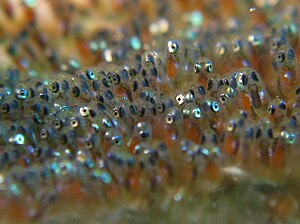
Back Kuit Afrikaans Frega AN سرء Arabic Nerštva BAT-SMG Mrijest BS Laich German Frajado Esperanto Freza Spanish Kudemine Estonian Errunaldi Basque

Spawn is the eggs and sperm released or deposited into water by aquatic animals. As a verb, to spawn refers to the process of freely releasing eggs and sperm into a body of water (fresh or marine); the physical act is known as spawning. The vast majority of non-mammalian, non-avian and non-reptilian aquatic and/or amphibious lifeforms reproduce through this process, including the:
- Bony and cartilaginous fishes (sharks, rays, etc.)
- Crustaceans (such as crabs, shrimps, etc.)
- Mollusks (such as oysters, octopus, squid)
- Echinoderms (such as sea urchins, sea stars, sea cucumbers, etc.)
- Amphibians (such as frogs, toads, salamanders, newts)
- Aquatic insects (such as dragonflies, mayflies, mosquitoes)
- Coral, which are living colonies of tiny, aquatic organisms—not plants, as they are sometimes perceived to be. Corals, while appearing sedentary or botanical by nature, actually spawn by releasing clouds of sperm and egg cells into the water column, where the two mix.
All other aquatic or amphibious creatures, by a large margin, reproduce through copulation (sexual intercourse); species of animals which do not reproduce through spawning are generally aquatic mammals, amphibious reptiles and sea and shore birds. This following species, all of which engage in various mating rituals (courtship), reproduce sexually:
- Cetaceans (dolphins, porpoises, whales)
- Pinnipeds (seals, sea lions, walrus)
- Rodents (such as beavers, muskrats, nutria)
- Mustelids (Eurasian otter and sea otters, mink, etc.)
- Water shrews
- Turtles (both sea turtles and freshwater turtles)
- Crocodiles, caimans and alligators
- Sea snakes (and sea kraits)
- Marine iguanas
- Wading birds, waterfowl, shorebirds, seagulls, albatrosses, etc.
Spawn consists of the reproductive cells (gametes) of many aquatic animals, some of which will become fertilized and produce offspring. The process of spawning typically involves females releasing ova (unfertilized eggs) into the water, often in large quantities, while males simultaneously or sequentially release spermatozoa (milt) to fertilize the eggs.[1][2][3]
The fungi (mushrooms), are also said to "spawn" when they release a white, ‘fibrous’ matter, forming the matrix from-which they grow.[citation needed]
There are many variations in the way spawning occurs, depending on sexual differences in anatomy, how the sexes relate to each other, where and how the spawn is released and whether or how the spawn is subsequently guarded.
- ^ Spawn Archived 2014-11-29 at the Wayback Machine Fishbase Glossary. Retrieved 3 February 2011.
- ^ Spawning Archived 2013-06-21 at the Wayback Machine Fishbase Glossary. Retrieved 3 February 2011.
- ^ Gametes Archived 2013-09-15 at the Wayback Machine Fishbase Glossary. Retrieved 3 February 2011.
© MMXXIII Rich X Search. We shall prevail. All rights reserved. Rich X Search